2 中国科学院大学, 北京 100049;
3 中国科学院大气物理研究所大气科学和地球流体力学数值模拟国家重点实验室, 北京 100029
2 University of Chinese Academy of Sciences, Beijing 100049;
3 State Key Laboratory of Numerical Modeling for Atmospheric Sciences and Geophysical Fluid Dynamics, Institute of Atmospheric Physics, Chinese Academy of Sciences, Beijing 100029
中国东北地区位于欧亚大陆的东岸,是我国主要的商品粮基地之一(周琳,1991),小麦、玉米和大豆等主要农作物通常在4~5月播种,在9月收割,生长期约为5个月(安刚等,1998;刘晓英和林而达,2003;陈莉等,2010)。但由于中国东北地区纬度高,气候寒冷,无霜期短,低温冷害是影响该地的农业生产一个重要的因素,也是该地农作物生长时期主要灾害性天气现象(东北低温科研协作组,1979;丁士晟,1980;刘晓英和林而达,2003;崔锦等,2007;房一禾等,2013)。因此,了解和研究中国东北地区该时期气温的时空变化规律,分析其与海温和大尺度环流指数之间的关系,对于该地的农业生产、生态系统以及经济活动有着极其重要的意义。
前人的研究表明,中国东北夏季气温的空间变化模态主要表现为全区一致型和南北反位相型(杨素英和王谦谦,2003;孙建奇和王会军,2006;张茜和李栋梁,2011;沈柏竹等,2012;Chen et al., 2016;李辑等,2016),时间上存在着明显的年代际特征(陈莉和朱锦红,2004;李辑和龚强,2006;李菲等,2010;沈柏竹等,2012)。影响中国东北夏季气温的天气环流系统主要包括东北冷涡(刘宗秀等,2002; Chen and Lu, 2014)、极涡(章少卿等,1985; 孙凤华等,2011)和马斯克林高压(曾宇星等,2014)等。ENSO(曾昭美和章名立,1987; 刘永强和丁一汇,1995;廉毅和安刚,1998; 刘实和王宁,2001; 朱益民等,2007; 王绍武等, 2009; Wu et al., 2010; 张霏燕和徐海明,2012; 胡心佳等,2016),太平洋年代际振荡(朱益民和杨修群,2003),春季南半球环状模(Zheng et al., 2015)和北太平洋振荡(刘宗秀等,2003; 沈柏竹等, 2011; Lian et al., 2013)等通过遥相关作用影响中国东北夏季气温。有研究还表明北大西洋和西风漂流带区等海域的海温异常也对中国东北夏季气温有较为显著的影响(章名立等,1983; 王敬方和吴国雄,1997; 郑维忠和倪允琪,1999; 李菲等,2010; 孙凤华等,2011; Wu et al., 2011; Lian et al., 2013)。另外,许多前人的研究在中国东北冬季气温异常的时空分布,相关的大气环流特征、物理成因及其预测因子等方面也取得了一系列重要的研究进展(武炳义和黄荣辉, 1999; 龚道溢,2000; Gong et al., 2001; 胡秀玲和刘宣飞,2005; 康丽华等, 2006, 2009; Chen and Li, 2007; Suo et al., 2009; 庞子琴和郭品文,2010; Chen and Zhou, 2012; 沈志超等,2013; Takaya and Nakamura, 2013; 杨柳妮和武炳义,2013; 苗青等,2016; 徐迪等,2017)。
以往的研究有助于提高我们对中国东北气温异常、物理成因等的认识,并为东北的农业生产及社会经济发展提供了科学参考。但是,其中一个不足之处是这些研究主要聚焦在夏季和冬季,对春季和秋季的关注较少。最近Zhuang et al. (2018)依据中国气象局的业务应用以及前人对东北季节划分的工作,将中国东北一年划分为冷暖两季,并对中国东北冷季(10月至次年4月)的气温变率及与大尺度环流的关系进行了研究。本文将对中国东北暖季气温的空间模态特征和变化特征,及与之相联系的大气环流和海温的关系进行研究分析。中国东北的暖季(5~9月)各月平均气温均超过了10 ℃ (Zhuang et al., 2018),大体对应于农作物的生长季(安刚等,1998)。我们进一步计算了(38°N~60°N,100°E~140°E)区域内5~9月各月的风矢量场与夏季平均风场之间的关系,结果表明二者的相关系数介于0.72~0.98之间,均通过了99.9%的显著性检验(图 1)。这些结果表明了中国东北暖季的环流特征与夏季具有较好的一致性。加深对暖季气温的时空变化特征及其可能成因的认识对中国东北的农业生产具有重要意义,同时也有助于中国东北实际的气候业务预报。
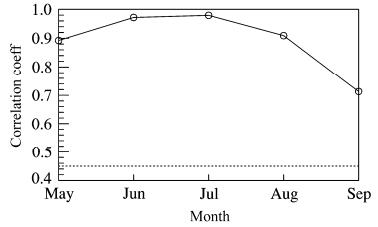
|
图 1 中国东北地区及其周边区域(38°N~60°N,100°E~140°E)暖季各月与夏季平均850 hPa风场的相关系数(虚线表示99.9%显著性检验) Fig. 1 Correlation coefficients of the summer mean wind field with winds in individual months from May to Sep at 850-hPa over Northeastern China (NEC) and its surrounding areas (38°N-60°N, 100°E-140°E). The dashed line denotes the 99.9% confidence level based on a two-sided Student's t-test |
本文采用了CRU TS3.24月平均气温(Harris et al., 2014)来分析中国东北暖季气温的时空变化特征,水平分辨率为0.5°(纬度)×0.5°(经度)。为了解释中国东北暖季气温变率与大尺度大气环流和全球海温异常之间的关系,本文采用了NCEP/NCAR提供的位势高度场和风场以及哈得莱中心的全球海温资料(Rayner et al., 2003)。另外,本文还分析了NCEP/NCAR大尺度大气环流指数,包括北极涛动(Arctic-Oscillation, AO)指数、北大西洋涛动(North Atlantic Oscillation, NAO)指数、El Niño指数(Niño1+2、Niño 3、Niño 3.4)、欧亚型(Polar/Eurasia pattern, POL)指数、太平洋年代际振荡(Pacific Decadal Oscillation, PDO)指数、太平洋—北美遥相关型指数(Pacific-North American Pattern, PNA),以及大西洋多年代际振荡(Atlantic Multidecedal Oscillation, AMO)指数与中国东北暖季气温的关系。本文所选取的时间段为1980~2014年。
本文采用经验正交函数(Empirical Orthogonal Function, EOF)方法分析中国东北暖季气温的主要空间模态型及其时间变化特征(Von Storch and Zwiers, 1999)。EOF分析方法突出的优点是没有固定的函数,能在有限的区域内对不规则站点进行时空分解,这样很容易将变量序列的信息集中在几个主要的模态上。其通常在分析一个物理变量的变化特征时,将变量序列分解为时间和空间两部分,得到变量最主要的空间变化型及相对应的时间系数,从而最大可能地解释原始变量的方差变化,反映变量的主要空间特征和时间变化特征(魏凤英,1999)。接着,采用M-K检验对气温进行突变测试。最后,采用相关分析和线性回归来解释中国东北暖季气温与海温异常和大尺度大气环流之间的关系。本文所用的检验方法为在一定置信水平下的t检验。
3 中国东北地区暖季气温异常的时空分布及相应的环流特征 3.1 时空分布特征为了了解中国东北暖季气温的典型空间模态分布特征,首先对中国东北1980~2014年的暖季气温进行EOF分析,结果表明:暖季气温的空间分布特征高度集中在前两个模态。其中,第一模态的解释方差为78.2%,第二模态的解释方差为8.6%,前两个模态的总解释方差达到86%以上(图 2)。根据North et al. (1982)标准,这两个主分量是相互独立的,且与其他主分量是可分开的,因此,本文选取前两个模态进行解释分析。
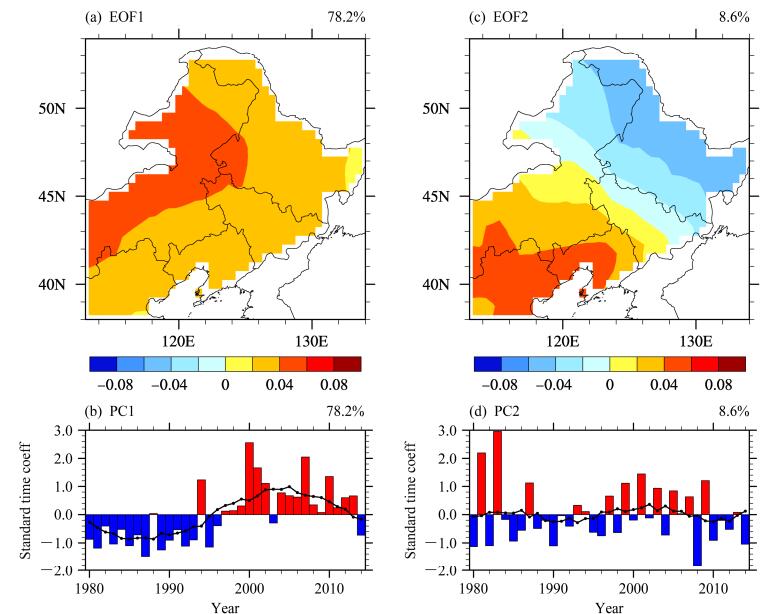
|
图 2 1980~2014年中国东北暖季气温EOF分析的(a)第一模态及其(b)对应的时间系数、(c)第二模态及其(d)对应的时间系数(实线代表 11年滑动平均) Fig. 2 Spatial patterns of EOF modes of the warm season surface air temperature (WSAT) over NEC and corresponding time series of normalized principal components (PCs): (a) The first EOF mode; (b) PC1; (c) the second EOF mode; (d) PC2. The solid line represents 11-year running mean |
图 2a和2b给出的是暖季气温第一模态的空间分布特征(EOF1)及其相应的时间系数(PC1)。从图中可知,EOF1在中国东北地区均为正值,这表明了中国东北暖季气温的变化呈现一致冷暖的特征,具有较好的全区一致性(图 2a)。相对应的时间系数PC1具有明显的年代际变化特征,在20世纪90年代中期以前,除了1988年和1994年为正位相外,其余均为负位相,东北全区暖季气温一致负异常,90年代中期至2014年,除2003年和2014年外,均为正位相,东北全区暖季气温一致正异常,暖季气温年代际变化趋势明显,从11年滑动平均也可以清楚地看出这种变化(图 2b)。M-K突变检验也说明了PC1在20世纪90年代中期发生了突变(图 3),结合滑动t检验的结果,可知中国东北暖季气温在1995/1996年突变明显(图略)。因此,可以将中国东北暖季气温变化分为前期温度偏低与后期温度偏高两个阶段(图 2b)。
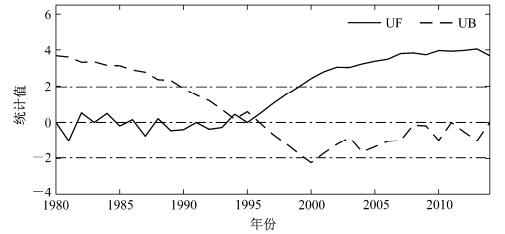
|
图 3 1980~2014年中国东北暖季气温PC1的M-K检验(虚线表示95%的显著性检验) Fig. 3 Mann-Kendall test of PC1 of the WSAT over NEC during 1980-2014 (dashed line represents the 95% confidence level) |
第二模态(EOF2)为南北反位相型,零线呈现西北—东南向,从118°E附近的中蒙交界处延伸至中国吉林与朝鲜的接壤处,零线北部为负值,南部为正值,这表明了中国东北暖季气温的变化又具有南北方向上不同的特征(图 2c)。相对应的时间系数PC2表现为年际变化特征和年代际变化特征,其功率谱图也表明其具有3~4年的年际周期和8年以上的年代际周期(图略)。11年滑动平均表明,20世纪80年代末前为正位相,80年代末至90年代中期为负位相,而后至2007年转变为正位相,之后又转变为负位相(图 2d)。这表明20世纪80年代末前,中国东北北部暖季气温负异常,80年代末至90年代中期,暖季气温正异常,而后气温又开始降低,2007年之后又升温,南部正好相反。
综上所述,中国东北暖季气温的空间变化主要集中在前两个模态上,主要表现为全区一致型和南北反位相型,且全区一致型的解释方差远大于南北反位相型,与东北夏季气温的前两个空间分布模态具有较好的一致性(杨素英和王谦谦,2003; 孙建奇和王会军,2006; 张茜和李栋梁,2011; 沈柏竹等,2012; 李辑等,2016)。中国东北暖季气温第一模态对应的时间系数PC1以年代际变化特征为主,并在1995/1996年发生了突变,而中国东北暖季气温第二模态对应的时间系数PC2表现为年际变化和年代际变化特征。
3.2 区域大气环流异常特征图 4是中国东北暖季气温PC1与500 hPa位势高度异常场和850 hPa异常风场的回归分析图。从图中可以看出,贝加尔湖以东地区的500 hPa位势高度值显著增加,正异常中心值超过12 gpm,此时整个东北地区处于此正异常区的控制下(图 4a),对应的850 hPa上存在一异常的反气旋环流(图 4b)。同时,200 hPa纬向风场上,40°N以北为正距平区,有纬向风的增强,而40°N以南为负距平区,有纬向风的减弱(图略),这些环流异常变化在中国东北地区均超过95%的信度检验。这表明,中国东北地区上空500 hPa位势高度的异常和200 hPa西风急流的位置对其暖季气温的变化具有重要的影响。
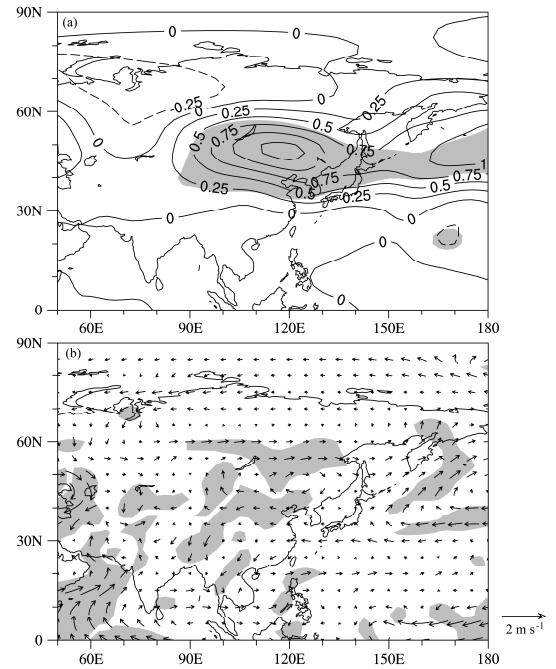
|
图 4 1980~2014年中国东北暖季气温PC1的环流回归分析(阴影表示通过95%的信度检验):(a)500 hPa位势高度(单位:gpm,等值线间隔为4 gpm)和(b)850 hPa风场 Fig. 4 Regression maps for (a) 500-hPa geopotential height and (b) 850-hPa wind based on time series of the normalized first principal component (PC1) of the WSAT over NEC during 1980-2014. Shaded areas are for values exceeding the 95% confidence level and the interval is 4 gpm in Fig. 4a |
当中国东北暖季气温一致偏高的时候,整个东北地区上空500 hPa高度上为正异常控制,减弱了东亚地区的经向环流,不利于中国东北以北地区的冷空气随槽后西北气流南下;而且200 hPa高空上西风急流的位置偏北,也不利于极地的冷空气南侵。在这样的高低层环流配置作用下,中国东北地区暖季气温呈现出整体偏高的特征。
图 5是中国东北暖季气温PC2与500 hPa高度异常场和850 hPa异常风场的回归分析图。从图中可以看出,贝加尔湖以东地区500 hPa位势高度值减小,负异常中心值小于-7 gpm,东北北部处于其显著范围控制内,南部为正位势高度异常,中心异常值大于1 gpm,但是其上空的位势高度正异常未达到显著程度(图 5a)。对应的850 hPa高度上,北部处于气旋及其偏北气流控制范围内,而且北部来自于高纬的寒冷空气对东北暖季气温的影响是显著的,给东北北部地区带来了强的冷平流,使得此地气温降低。南部受气旋南部的偏西气流以及来自于中低纬偏南暖湿气流的影响,气温偏高,但是未通过95%的显著性检验,这些环流的异常对南部的影响不显著(图 5b),反之亦然。
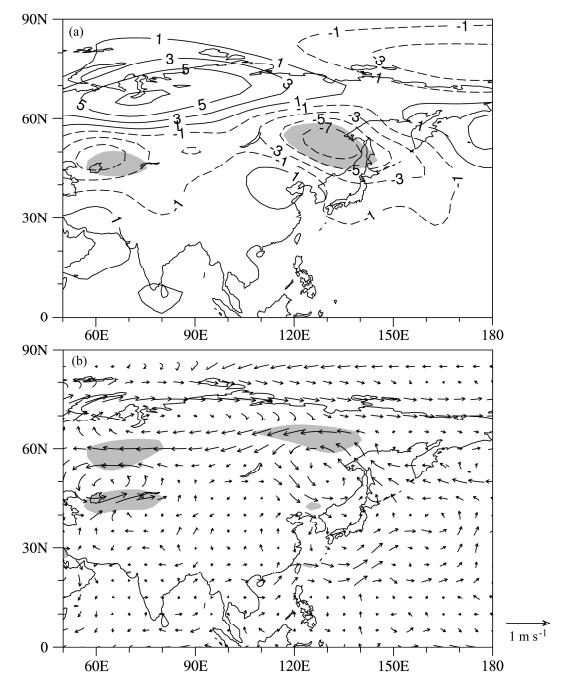
|
图 5 同图 4,但为中国东北暖季气温PC2的环流回归分析(阴影表示通过95%的显著性检验,已去掉零线):(a)500 hPa位势高度(单位:gpm,等值线间隔为2 gpm)和(b)850 hPa风场 Fig. 5 Same as Fig. 4, but for time series of thenormalized second principal component (PC2) of the WSAT over NEC. Shaded areas are for values exceeding the 95% confidence level. The interval is 2 gpm in Fig. 5a |
综上所述,与中国东北暖季气温EOF1相联系的环流形势趋于一致正异常,与中国东北暖季气温EOF2相联系的大气环流则表现出南北位势高度反相的特征。可见,中国东北暖季气温的高低与其上空位势高度的异常有较大的关系。当中国东北整个地区上空的环流形势趋于一致变化时,则中国东北暖季气温变化就表现出全区一致性。如果中国东北南北部的环流形势异常反相,则中国东北暖季气温变化就表现出南北反相的特征,即当北部上空为负异常控制时,其气温偏低,反之偏高;南部也是如此。
4 中国东北暖季气温异常与海温的关系图 6给出的是中国东北暖季气温PC1与全球海温的关系。图 6b是与中国东北暖季气温变化相对应的同期全球海温分布,可以看出北太平洋中西部,中国沿海(东海)、日本海及黑潮延伸区、靠近北美大陆东部的北大西洋、印度洋海域以及南太平洋环澳大利亚东海岸等海域的海温异常与中国东北暖季气温的变化密切相关,二者呈显著正相关, 这些异常信号都通过了95%信度检验。而暖季气温与南极附近海域的海温异常呈负相关,与赤道中东太平洋海温异常的负相关较弱。其中与北太平洋中部,日本海及黑潮延伸区和我国邻海(东海)海域的海温异常相关性较好,将这3个关键海区的海温提取出来,分别计算出这3个海域的海温异常与PC1的相关系数,结果发现PC1与日本海及黑潮延伸区海域区(31°N~45°N,130°E~150°E)的海温异常同期相关最高,相关系数高达0.69以上,通过99%的显著性检验。此外,菲律宾以东的西太平洋、北太平洋中部、中国东南沿海、北大西洋的正相关可以追溯至前1~4个月(图 6a),此时正相关达0.5以上,到了暖季时期,相关有所减弱(图 6b)。

|
图 6 1980~2014年中国东北暖季气温PC1与(a)前期1~4月和(b)同年暖季海面温度异常的相关系数(带点区表示通过95%的信度检验) Fig. 6 Correlation coefficients of time series of the normalized first principal component (PC1) of the WAST over NEC with SST anomalies (a) in the preceding Jan-Apr and (b) in the warm season for the period of 1980-2014. Dotted areas are for values exceeding the 95% confidence level |
进一步对日本海及黑潮延伸区海域暖季时期的海温异常值进行突变测试,发现此海域的海温异常在1990年代初发生了突变(图 7),由于海温异常对大气的影响有滞后关系(徐海明,1997;侯伟芬等,2004),因此我们认为这可能是造成中国东北暖季气温在1990年代中期突变的原因。而且将此海域暖季时期的海温异常值回归至500 hPa位势高度异常场和850 hPa风场异常场上,也可以看出其环流形势与中国东北暖季气温EOF1所对应的环流形势类似,即中国东北上空850 hPa高度上为异常的反气旋环流以及500 hPa上空为正位势高度异常控制。这样一种环流形势,不利于高纬冷空气南下,同时反气旋东侧的异常东南风将海上暖湿空气输送至中国东北地区,造成该地区暖季地面气温异常偏高。
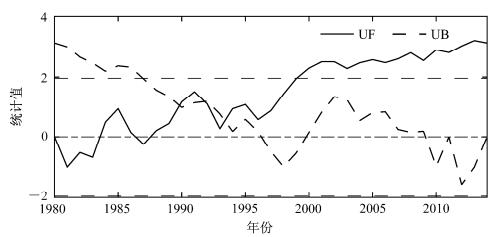
|
图 7 日本海及黑潮延伸区(31°N~45°N,130°E~150°E)暖季(5~9月)平均海面温度异常的M-K突变(虚线表示0.05的显著性检验) Fig. 7 Mann-Kendall test of the warm season average SST anomalies over the Sea of Japan and the Kuroshio Extension region (31°N-45°N, 130°E-150°E). The dashed line represents the 95% confidence level |
从PC2与全球海温异常的关系图中可以看出,PC2主要与黑潮延伸区海域的海温异常为显著的负相关,与东太平洋海域的海温异常为弱的正相关,其余海域的相关普遍不明显(图 8)。
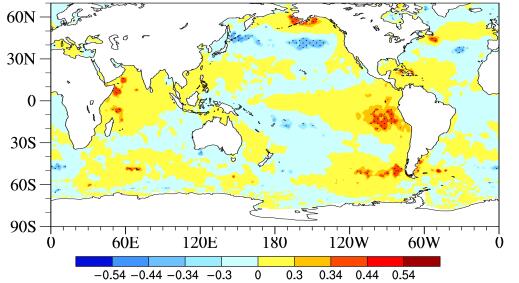
|
图 8 1980~2014年中国东北暖季气温PC2与海面温度的相关关系(带点区表示通过0.05的显著性检验) Fig. 8 Same as Fig. 6, but for time series of the normalized second principal component (PC2) of the WSAT over NEC (area with dots are above 95% confidence level) |
由以上分析可以得出日本海及黑潮延伸区海域暖季时期的海温异常对中国东北暖季气温EOF1的同期影响最大,其海温异常在1990年代初发生了突变,可能是造成中国东北暖季气温1990年代中期突变的原因。而菲律宾以东的西太平洋、北太平洋中部、中国东南沿海、靠近北美东北部的北大西洋的海温对中国东北暖季气温EOF1的出现具有预测作用。PC2与黑潮延伸区海域的海温异常的关系最强,其余海域的相关普遍不明显。
5 东北暖季气温与大尺度环流指数的关系从PC1相联系的海温分布场也可以看出(图 6b),中国东北暖季气温变化深受西太平洋和北大西洋这两个海域海温异常的影响,而这两个海域的海温异常与PDO和AMO指数的位相变化又密切相关(Enfield et al., 2001; Mantua and Hare, 2002),于是我们进一步计算了中国东北暖季气温与大尺度环流指数的相关系数。这里的相关系数检验所采用的自由度是有效自由度Bretherton et al. (1999)。从图 9可知,PC1与PDO指数的相关最密切,相关系数为-0.57,其有效自由度为24,为显著的负相关,通过了99%的显著性检验。当PDO为暖位相时期,热带中东太平洋海表温度异常增暖,北太平洋中西部海表温度异常变冷(Mantua and Hare, 2002),则中国东北暖季气温偏低;PDO冷位相时期,中国东北暖季气温的变化趋势与上述相反。即当PDO处于不同位相时,中国东北暖季气温与太平洋海温的相关性也有所不同,说明PDO对中国东北暖季气温与太平洋海温异常的相关关系具有调制作用,这与中国东北夏季气温与太平洋海温之间的关系具有较好的一致性(李菲等,2010)。其次是AMO指数,相关系数为0.36,其有效自由度为24,通过了90%的显著性检验。而且将这两个指数回归至5~9月的大尺度大气环流场上,其所对应的大尺度大气环流形势也与PC1的环流形势相似。但是由于受个别年份的影响,PC1所对应的海温分布场与PDO和AMO这两个大尺度指数型所对应的海温分布型有所差异。虽然PC1与El Niño指数为负相关,但是相关系数没有通过显著性检验,说明从20世纪80年代起,El Niño事件对中国东北暖季气温的整体变化影响不大,这与早期关于中国东北夏季气温与ENSO的关系研究较为一致(朱益民等, 2007; Wu et al., 2010)。
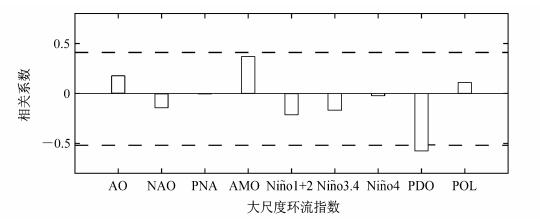
|
图 9 1980~2014年中国东北暖季气温PC1与大尺度环流指数的相关关系(上虚线表示90%的显著性检验,下虚线表示99%的显著性检验) Fig. 9 Correlation coefficients between time series of the normalized first component (PC1) of the WAST over NEC and global climate indices during 1980- 2014. The upper dashed line represents the 90% confidence level and the lower dashed line represents the 99% confidence level |
从1980~2014年整个时段的PC2与大尺度环流指数的同期相关结果可以看出,虽然其与Niño1+2和PDO指数的正相关最大,可是相关系数都达不到显著性水平(图 10a)。但是在1990年代中期突变前,PC2与Niño1+2指数的正相关最大,相关系数为0.63,其有效自由度为17,通过了95%显著性水平(图 10b);而在1990年代中期突变后,PC2与Niño1+2指数的相关性转变为负相关,但是却不显著,与NAO指数的正相关性增强,并通过了90%显著性检验(图 10c),其余指数的相关均不显著。这说明了突变前后ENSO事件对中国东北暖季气温的影响不同。从PC2与Niño1+2指数相关系数的空间分布也可以看出,在突变前ENSO事件与东北北部暖季气温变化为显著的负相关,而与其南部地区为正相关,此空间分布特征与EOF2的空间模态特征相似,呈现南北反向相关(图 11a);而突变后,只有内蒙古中部的小片区域为负相关,其余地区的相关不显著(图 11b)。

|
图 10 (a)1980~2014年、(b)1980~1995年和(c)1996~2014年中国东北暖季气温PC2与大尺度指数的相关关系(a、b中虚线表示95%的显著性检验,c中虚线表示90%的显著性检验) Fig. 10 Correlation coefficients between time series of the normalized second component (PC2) of the WAST over NEC and global climate indices for (a) the period of 1980-2014, (b) the period of 1980-1995, and (c) the period of 1996-2014, respectively (dashed lines in Fig. 10a and Fig. 10b represent the 95% confidence level and the dashed line in Fig. 10c represents the 90% confidence levels) |

|
图 11 (a)1980~1995和(b)1996~2014中国东北暖季气温PC2与ENSO(Niño 1+2指数)的相关关系(带点区表示通过90%的显著性检验) Fig. 11 Spatial distributions of correlation coefficients between time series of the normalized second component (PC2) of the WSAT over NEC and ENSO (Niño 1+2 index) for (a) 1980-1995 and (b) 1996-2014, respectively. The areas with dots are for values exceeding the 90% confidence level |
综上所述,中国东北暖季气温PC1与年代际指数PDO和AMO指数相关显著,两个指数的海温分布型及其环流回归均与PC1本身所对应的相似。虽然整个时段的PC2与大尺度环流指数相关不显著,但在1990年代中期突变前,其主要受到ENSO事件的影响,而之后影响就减弱了。
6 结论与讨论本文利用1980~2014年CRU TS3.24的月平均气温数据、NCEP/NCAR的位势高度场和风场、哈得莱中心提供的全球海温资料和NCEP/NCAR的大尺度环流指数,对中国东北暖季气温的时空变化特征及其与海温和大尺度环流指数的关系进行了分析,主要结论如下:
中国东北暖季气温的EOF分析结果表明其空间模态主要表现为全区一致型和南北反位相型,二者分别解释了78.2%和8.6%的方差,总解释方差超过了86%。这说明了中国东北暖季气温的变化不仅受到大尺度环流的影响,而且还受到局地气象条件的影响,比如地形、土壤温度、土壤湿度、雪盖等等(张茜和李栋梁,2012; 张井勇和吴凌云,2014; 李启芬等,2016)。第一模态对应的时间系数PC1具有明显的年代际变化特征,并在1990年代中期发生了显著的突变。而第二模态对应的时间系数PC2具有明显的年际和年代际变化特征。
进一步对中国东北暖季气温的前两个模态进行环流形势分析,可知中国东北暖季气温的变化与其上空500 hPa位势高度的异常有很好的关系。与全区一致型增暖对应着500 hPa位势高度正异常和850 hPa反气旋环流异常。而与南北反位相型相联系的500 hPa环流形势则表现出南北位势高度符号相反。即当东北全区环流形势趋于一致正异常时,气温一致偏高,反之亦然;当东北全区环流形势南北反位相异常时,气温也发生南北反相变化。
最后,对中国东北暖季气温与全球海温异常和大尺度环流的关系进行了相关分析,发现中国东北暖季气温PC1主要受西太平洋和北大西洋的影响。其中日本海及黑潮延伸区海域的海温异常与其同期变化相关最紧密,此海域海温在1990年代初发生了突变,这可能是造成中国东北暖季气温PC1在1990年代中期发生突变的重要原因。菲律宾以东的西太平洋、北太平洋中部、中国东南沿海、靠近北美东北部的北大西洋等海域的海温异常对中国东北暖季气温全区一致型的出现具有一定的预测作用。PC2除了与黑潮延伸区海域的海温异常为显著的负相关外,其余海域的相关关系不明显。
虽然中国东北暖季气温PC1与赤道中东太平洋海温的相关性较弱,但是却与太平洋海温年代际振荡相联系的PDO指数相关显著,表明PC1的变化与北半球海气系统的年代际变化相关密切。其次是与AMO正相关显著。而1980~2014年PC2与大尺度环流指数相关普遍不明显,但是在1990年代中期突变前,其与Niño1+2指数正相关显著,说明ENSO事件对其年际变化起重要作用,之后影响则不明显。
本文主要分析了中国东北暖季气温的时空特征及其与大尺度大气环流和海温的关系,主要是以统计分析为主,分析的结果与前人的研究成果相似(沈柏竹等,2012)。但前人大部分是基于传统的夏季(6~8月),而本文根据中国气象局的业务应用和前人对季节划分的研究把5月和9月与夏季合并为暖季,这大体与东北农作物生长季对应(安刚等,1998)。对中国东北暖季气温进行分析能够为东北农作物的生长以及农业生产提供参考价值。另外,本文在做与大尺度环流指数相关时,都只是单独考虑了大尺度指数与中国东北暖季气温的关系,而没有考虑到大尺度指数之间的联系及其对中国东北暖季气温的作用。前人的研究也表明了大尺度指数之间的相互作用也会对中国气候异常产生影响(朱益民和杨修群,2003;Chen et al., 2013)。那么,其对中国东北地区暖季气温的异常变化会产生什么样的影响呢?而且关键区的海温异常对中国东北暖季气温变化产生影响的具体过程如何?这都有待于下一步深入研究。
| [] | 安刚, 廉毅, 王琪. 1998. 近九十年吉林省松辽平原作物生长季气温变化的小波分析[J]. 气象学报, 56(4): 458–466. An Gang, Lian Yi, Wang Qi. 1998. The wavelet analysis of temperature variations of Song-liao Plain in crop growth period[J]. Acta Meteorologica Sinica (in Chinese), 56(4): 458–466. DOI:10.11676/qxxb1998.040 |
| [] | Bretherton C S, Widmann M, Dymnikov V P, et al. 1999. The effective number of spatial degrees of freedom of a time-varying field[J]. J. Climate, 12(7): 1990–2009. DOI:10.1175/1520-0442(1999)012<1990:TENOSD>2.0.CO;2 |
| [] | 陈莉, 朱锦红. 2004. 东北亚冷夏的年代际变化[J]. 大气科学, 28(2): 241–253. Chen Li, Zhu Jinhong. 2004. Inter decadal variability of cool summer of northeastern Asia[J]. Chinese Journal of Atmospheric Sciences (in Chinese), 28(2): 241–253. DOI:10.3878/j.issn.1006-9895.2004.02.07 |
| [] | 陈莉, 方丽娟, 李帅. 2010. 东北地区近50年农作物生长季干旱趋势研究[J]. 灾害学, 25(4): 5–10. Chen Li, Fang Lijuan, Li Shuai. 2010. Study on drought trend of crop growing season in northeast China in recent 50 years[J]. Journal of Catastrophology (in Chinese), 25(4): 5–10. DOI:10.3969/j.issn.1000-811X.2010.04.002 |
| [] | Chen W, Li T. 2007. Modulation of Northern Hemisphere wintertime stationary planetary wave activity:East Asian climate relationships by the Quasi-Biennial Oscillation[J]. J. Geophys. Res., 112: D20120. DOI:10.1029/2007JD008611 |
| [] | Chen W, Zhou Q. 2012. Modulation of the Arctic Oscillation and the East Asian winter climate relationships by the 11-year solar cycle[J]. Advances in Atmospheric Sciences, 29(2): 217–226. DOI:10.1007/s00376-011-1095-3 |
| [] | Chen W, Lu R Y. 2014. The interannual variation in monthly temperature over northeast China during summer[J]. Advances in Atmospheric Sciences, 31(3): 515–524. DOI:10.1007/s00376-013-3102-3 |
| [] | Chen W, Lan X Q, WangL, et al. 2013. The combined effects of the ENSO and the Arctic Oscillation on the winter climate anomalies in East Asia[J]. Chinese Science Bulletin, 58(12): 1355–1362. DOI:10.1007/s11434-012-5654-5 |
| [] | Chen W, Hong X W, Lu R Y, et al. 2016. Variation in summer surface air temperature over northeast Asia and its associated circulation anomalies[J]. Advances in Atmospheric Sciences, 33(1): 1–9. DOI:10.1007/s00376-015-5056-0 |
| [] | 崔锦, 李辑, 张爱忠, 等. 2007. 东北夏季低温的研究进展[J]. 气象, 33(4): 3–9. Cui Jin, Li Ji, Zhang Aizhong, et al. 2007. Advances in studies of summer low temperature in northeast China[J]. Meteorological Monthly (in Chinese), 33(4): 3–9. DOI:10.3969/j.issn.1000-0526.2007.04.001 |
| [] | 丁士晟. 1980. 东北地区夏季低温的气候分析及其对农业生产的影响[J]. 气象学报, 38(3): 234–242. Ding Shisheng. 1980. The climatic analysis of low temperature in summer over the northeast China and influence for agricultural product[J]. Acta Meteorologica Sinica (in Chinese), 38(3): 234–242. DOI:10.11676/qxxb1980.028 |
| [] | 东北低温科研协作组. 1979. 东北地区冷夏、热夏长期预报的初步研究[J]. 气象学报, 37(3): 44–58. Northeast China Gold Summer Research Group. 1979. A preliminary study on the longrange forecasting of the cold/warm summer in northeast China[J]. Acta Meteorologica Sinica (in Chinese), 37(3): 44–58. DOI:10.11676/qxxb1979.028 |
| [] | Enfield D B, Mestas-Nuñez A M, Trimble P J. 2001. The Atlantic multidecadal oscillation and its relation to rainfall and river flows in the continental U.S.[J]. Geophys. Res. Lett., 28(10): 2077–2080. DOI:10.1029/2000GL012745 |
| [] | 房一禾, 李辑, 周放. 2013. 东北夏季低温冷害影响因子研究进展及展望[J]. 中国农学通报, 29(23): 194–200. Fang Yihe, Li Ji, Zhou Fang. 2013. Research progress and prospect of summer freezing damage's impact factors in northeast China[J]. Chinese Agricultural Science Bulletin (in Chinese), 29(23): 194–200. DOI:10.3969/j.issn.1000-6850.2013.23.034 |
| [] | 龚道溢. 2000. 大尺度大气环流变化及其对北半球冬季温度的影响[J]. 地学前缘, 7(S2): 203–208. Gong Daoyi. 2000. Large-scale atmospheric circulation and its influence on winter temperature in the Northern Hemisphere[J]. Earth Science Frontiers (in Chinese), 7(S2): 203–208. |
| [] | Gong D Y, Wang S W, Zhu J H. 2001. East Asian winter monsoon and Arctic oscillation[J]. Geophys. Res. Lett., 28(10): 2073–2076. DOI:10.1029/2000GL012311 |
| [] | Harris I, Jones P D, Osborn T J, et al. 2014. Updated high-resolution grids of monthly climatic observations-The CRU TS3.10 dataset[J]. International Journal of Climatology, 34(3): 623–642. DOI:10.1002/joc.3711 |
| [] | 侯伟芬, 王谦谦, 刘燕. 2004. 江南地区夏季气温异常与全球海温异常的相关关系[J]. 南京气象学院学报, 27(4): 539–544. Hou Weifen, Wang Qianqian, Liu Yan. 2004. Summer temperature anomalies in Southern China in relation to the global abnormal sea surface temperatures[J]. Journal of Nanjing Institute of Meteorology (in Chinese), 27(4): 539–544. DOI:10.3969/j.issn.1674-7097.2004.04.014 |
| [] | 胡心佳, 汪明, 李艳, 等. 2016. ENSO-Modoki与东北三省夏季温度异常事件的关系[J]. 干旱气象, 34(2): 282–289. Hu Xinjia, Wang Ming, Li Yan, et al. 2016. Relationship between ENSO-Modoki and summer temperature anomaly event in northeastern China[J]. Journal of Arid Meteorology (in Chinese), 34(2): 282–289. DOI:10.11755/j.issn.1006-7639(2016)-02-0282 |
| [] | 胡秀玲, 刘宣飞. 2005. 东北地区冬季气温与北极涛动年代际关系研究[J]. 南京气象学院学报, 28(5): 640–648. Hu Xiuling, Liu Xuanfei. 2005. Decadal relationship between winter air temperature in northeast China and Arctic Oscillations[J]. Journal of Nanjing Institute of Meteorology (in Chinese), 28(5): 640–648. DOI:10.13878/j.cnki.dqkxxb.2005.05.009 |
| [] | 康丽华, 陈文, 魏科. 2006. 我国冬季气温年代际变化及其与大气环流异常变化的关系[J]. 气候与环境研究, 11(3): 330–339. Kang Lihua, Chen Wen, Wei Ke. 2006. The interdecadal variation of winter temperature in China andits relation to the anomalies in atmospheric general circulation[J]. Climatic and Environmental Research (in Chinese), 11(3): 330–339. DOI:10.3878/j.issn.1006-9585.2006.03.09 |
| [] | 康丽华, 陈文, 王林, 等. 2009. 我国冬季气温的年际变化及其与大气环流和海温异常的关系[J]. 气候与环境研究, 14(1): 45–53. Kang Lihua, Chen Wen, Wang Lin, et al. 2009. Interannual variations of winter temperature in China and their relationship with the atmospheric circulation and sea surface temperature[J]. Climatic and Environmental Research (in Chinese), 14(1): 45–53. DOI:10.3878/j.issn.1006-9585.2009.01.05 |
| [] | 李菲, 李辑, 管兆勇. 2010. 我国东北夏季气温年代际变化特征及与太平洋海温异常关系的研究[J]. 气象与环境学报, 26(3): 19–26. Li Fei, Li Ji, Guan Zhaoyong. 2010. Inter-decadal variations of summer temperature in northeast China and relationships with Pacific SSTA[J]. Journal of Meteorology and Environment (in Chinese), 26(3): 19–26. DOI:10.3969/j.issn.1673-503X.2010.03.004 |
| [] | 李辑, 龚强. 2006. 东北地区夏季气温变化特征分析[J]. 气象与环境学报, 22(1): 6–10. Li Ji, Gong Qiang. 2006. Characteristics of summer air temperature in northeast China[J]. Journal of Meteorology and Environment (in Chinese), 22(1): 6–10. DOI:10.3969/j.issn.1673-503X.2006.01.002 |
| [] | 李辑, 焦敏, 胡春丽, 等. 2016. 1951~2012年东北地区夏季气温及其影响因子变化特征[J]. 气象与环境学报, 32(5): 74–83. Li Ji, Jiao Min, Hu Chunli, et al. 2016. Characteristics of summer temperature and its impact factors in northeast China from 1951 to 2012[J]. Journal of Meteorology and Environment (in Chinese), 32(5): 74–83. DOI:10.3969/j.issn.1673-503X.2016.05.011 |
| [] | 李启芬, 刘婷婷, 陈海山, 等. 2016. 基于土壤湿度和年际增量方法的中国夏季气温预测试验[J]. 气象科学, 36(5): 629–638. Li Qifen, Liu Tingting, Chen Haishan, et al. 2016. Prediction of summer temperature in China based on soil moisture and interannual increment approach[J]. Journal of the Meteorological Sciences (in Chinese), 36(5): 629–638. DOI:10.3969/2015jms.0060 |
| [] | 廉毅, 安刚. 1998. 东亚季风El Niño与中国松辽平原夏季低温关系初探[J]. 气象学报, 56(6): 724–735. Lian Yi, An Gang. 1998. The relationship among East Asia summer monsoon El Niño and low temperature in Songliao Plains northeast China[J]. Acta Meteorologica Sinica(in Chinese), 56(6): 724–735. DOI:10.11676/qxxb1998.066 |
| [] | Lian Y, Shen B Z, Li S F, et al. 2013. Impacts of polar vortex, NPO, and SST configurations onunusually cool summers in northeast China.Part Ⅰ:Analysis and diagnosis[J]. Advances in Atmospheric Sciences, 30(1): 193–209. DOI:10.1007/s00376-012-1258-x |
| [] | 刘实, 王宁. 2001. 前期ENSO事件对东北地区夏季气温的影响[J]. 热带气象学报, 17(3): 314–319. Liu Shi, Wang Ning. 2001. The impacts of antecedent ENSO event on air temperature over northeast China in summer[J]. Journal of Tropical Meteorology (in Chinese), 17(3): 314–319. DOI:10.3969/j.issn.1004-4965.2001.03.016 |
| [] | 刘晓英, 林而达. 2003. 东北地区农作物生长期内温度变化的时空特征[J]. 中国农业气象, 24(1): 11–15. Liu Xiaoying, Lin Erda. 2003. Temporal and spatial distribution of temperature during crowing season of crops in northeast China[J]. Chinese Journal of Agrometeorology (in Chinese), 24(1): 11–15. DOI:10.3969/j.issn.1000-6362.2003.01.004 |
| [] | 刘永强, 丁一汇. 1995. ENSO事件对我国季节降水和温度的影响[J]. 大气科学, 19(2): 200–208. Liu Yongqiang, Ding Yihui. 1995. Reappraisal of the influence of ENSO events on seasonal precipitation and temperature in China[J]. Chinese Journal of Atmospheric Sciences (in Chinese), 19(2): 200–208. DOI:10.3878/j.issn.1006-9895.1995.02.09 |
| [] | 刘宗秀, 廉毅, 高枞亭, 等. 2002. 东北冷涡持续活动时期的北半球500 hPa环流特征分析[J]. 大气科学, 26(3): 361–372. Liu Zongxiu, Lian Yi, Gao Zongting, et al. 2002. Analyses of the Northern Hemisphere circulation charactersduring northeast Cold Vortex persistence[J]. Chinese Journal of Atmospheric Sciences (in Chinese), 26(3): 361–372. DOI:10.3878/j.issn.1006-9895.2002.03.07 |
| [] | 刘宗秀, 廉毅, 沈柏竹, 等. 2003. 北太平洋涛动区500 hPa高度场季节变化特征及其对中国东北区降水的影响[J]. 应用气象学报, 14(5): 553–561. Liu Zongxiu, Lian Yi, Shen Baizhu, et al. 2003. Seasonal variation features of 500 hPa height in North Pacific Oscillation region and its effect on precipitation in northeast China[J]. Journal of Applied Meteorological Science (in Chinese), 14(5): 553–561. DOI:10.3969/j.issn.1001-7313.2003.05.005 |
| [] | Mantua N J, Hare S R. 2002. The Pacific decadal oscillation[J]. Journal of Oceanography, 58(1): 35–44. DOI:10.1023/A:1015820616384 |
| [] | 苗青, 巩远发, 邓锐捷, 等. 2016. 北半球中高纬度低频振荡对2012/2013年冬季中国东北极端低温事件的影响[J]. 大气科学, 40(4): 817–830. Miao Qing, Gong Yuanfa, Deng Ruijie, et al. 2016. Impacts of the low-frequency oscillation over the extra-tropics of the Northern Hemisphere on the extreme low temperature event in northeast China in the winter of 2012/2013[J]. Chinese Journal of Atmospheric Sciences (in Chinese), 40(4): 817–830. DOI:10.3878/j.issn.1006-9895.1508.15189 |
| [] | North G R, Bell T L, Cahalan R F, et al. 1982. Sampling errors in the estimation of empirical orthogonal functions[J]. Mon. Wea. Rev., 110(7): 699–706. DOI:10.1175/1520-0493(1982)110<0699:SEITEO>2.0.CO;2 |
| [] | 庞子琴, 郭品文. 2010. 不同年代际背景下AO与冬季中国东北气温的关系[J]. 大气科学学报, 33(4): 469–476. Pang Ziqin, Guo Pinwen. 2010. Interdecadal variationof relationship between AO and winter temperature interannual variability in northeast China[J]. Transactions of Atmospheric Sciences (in Chinese), 33(4): 469–476. DOI:10.3969/j.issn.1674-7097.2010.04.011 |
| [] | Rayner N A, Parker D E, Horton E B, et al. 2003. Global analyses of sea surface temperature, sea ice, and night marine air temperature since the late nineteenth century[J]. J. Geophys. Res., 108(D14): 4407. DOI:10.1029/2002JD002670 |
| [] | 沈柏竹, 刘实, 廉毅, 等. 2011. 2009年中国东北夏季低温及其与前期海气系统变化的联系[J]. 气象学报, 69(2): 320–333. Shen Baizhu, Liu Shi, Lian Yi, et al. 2011. An investigation into 2009 summer low temperature in northeast China and its association with prophase changes of the air-sea system[J]. Acta Meteorologica Sinica (in Chinese), 69(2): 320–333. DOI:10.11676/qxxb2011.027 |
| [] | 沈柏竹, 廉毅, 杨涵洧, 等. 2012. 中国东北夏季温度年代际变化特征[J]. 地理科学, 32(6): 739–745. Shen Baizhu, Lian Yi, Yang Hanyou, et al. 2012. Interdecadal change characteristics of summer temperature in northeast China[J]. Scientia Geographica Sinica (in Chinese), 32(6): 739–745. DOI:10.13249/j.cnki.sgs.2012.06.739 |
| [] | 沈志超, 任国玉, 李娇, 等. 2013. 中国东北地区冬季气温变化特征及其与大气环流异常的关系[J]. 气象与环境学报, 29(1): 47–54. Shen Zhichao, Ren Guoyu, Li Jiao, et al. 2013. Winter temperature variability and its relationship with atmospheric circulation anomalies in northeast China[J]. Journal of Meteorology and Environment (in Chinese), 29(1): 47–54. DOI:10.3969/j.issn.1673-503X.2013.01.008 |
| [] | 孙凤华, 李丽光, 张耀存. 2011. 影响中国东北地区气候的关键区、关键时段和关键因子[J]. 地理科学, 31(8): 911–916. Sun Fenghua, Li Liguang, Zhang Yaocun. 2011. Key zone, key period and key factor influencing climate in northeast China[J]. Scientia Geographica Sinica (in Chinese), 31(8): 911–916. DOI:10.13249/j.cnki.sgs.2011.08.018 |
| [] | 孙建奇, 王会军. 2006. 东北夏季气温变异的区域差异及其与大气环流和海表温度的关系[J]. 地球物理学报, 49(3): 662–671. Sun Jianqi, Wang Huijun. 2006. Regional difference of summer air temperature anomalies in northeast China and its relationship to atmospheric general circulation and sea surface temperature[J]. Chinese Journal of Geophysics (in Chinese), 49(3): 662–671. DOI:10.3321/j.issn:0001-5733.2006.03.008 |
| [] | Suo L L, Tan B K, Huang J Y. 2009. Further exploration on causes of temperature anomalies associated with the abnormal northern annular mode[J]. Chinese Science Bulletin, 54(12): 2101–2106. DOI:10.1007/s11434-009-0045-2 |
| [] | Takaya K, Nakamura H. 2013. Interannual variability of the East Asian winter monsoon and related modulations of the planetary waves[J]. J. Climate, 26(23): 9445–9461. DOI:10.1175/JCLI-D-12-00842.1 |
| [] | Von Storch H, Zwiers FW. 1999. Statistical Analysis in Climate Research[M]. Cambridge: Cambridge University Press. |
| [] | 王敬方, 吴国雄. 1997. 持续性东北冷夏的变化规律及相关特征[J]. 大气科学, 21(5): 523–532. Wang Jingfang, Wu Guoxiong. 1997. Evolution and characteristics of the persistent cold summer in northeast China[J]. Chinese Journal of Atmospheric Sciences (in Chinese), 21(5): 523–532. DOI:10.3878/j.issn.1006-9895.1997.05.02 |
| [] | 王绍武, 马树庆, 陈莉, 等. 2009. 低温冷害[M]. 北京: 气象出版社: 115-123. Wang Shaowu, Ma Shuqing, Chen Li, et al. 2009. Chilling Damage (in Chinese)[M]. Beijing: China Meteorological Press: 115-123. |
| [] | 魏凤英. 1999. 现代气候统计诊断与预测技术[M]. 北京: 气象出版社: 105-115. Wei Fengying. 1999. Modern Statistical Diagnosis and Prediction Technology on Climate (in Chinese)[M]. Beijing: China Meteorological Press: 105-115. |
| [] | 武炳义, 黄荣辉. 1999. 冬季北大西洋涛动极端异常变化与东亚冬季风[J]. 大气科学, 23(6): 641–651. Wu Bingyi, Huang Ronghui. 1999. Effects of the extremes in the North Atlantic oscillation on East Asia winter monsoon[J]. Chinese Journal of Atmospheric Sciences (in Chinese), 23(6): 641–651. DOI:10.3878/j.issn.1006-9895.1999.06.01 |
| [] | Wu R G, Yang S, Liu S, et al. 2010. Changes in the relationship between northeast China summer temperature and ENSO[J]. J. Geophys. Res., 115(D21): D21107. DOI:10.1029/2010JD014422 |
| [] | Wu R G, Yang S, Liu S, et al. 2011. Northeast China summer temperature and North Atlantic SST[J]. J. Geophys. Res., 116(D16): D16116. DOI:10.1029/2011JD015779 |
| [] | 徐迪, 任保华, 郑建秋, 等. 2017. 中国东北地区冬季气温趋势及反相模态分析[J]. 气象科学, 37(1): 127–133. Xu Di, Ren Baohua, Zheng Jianqiu, et al. 2017. Analysis of trend pattern and seesaw pattern of winter temperature in northeast China[J]. Journal of the Meteorological Sciences (in Chinese), 37(1): 127–133. DOI:10.3969/2016jms.0005 |
| [] | 徐海明. 1997. 华南夏季降水与全球海温的关系[J]. 南京气象学院学报, 20(3): 392–399. Xu Haiming. 1997. Relationship between South China summer precipitation and global SST[J]. Journal of Nanjing Institute of Meteorology (in Chinese), 20(3): 392–399. DOI:10.13878/j.cnki.dqkxxb.1997.03.018 |
| [] | 杨柳妮, 武炳义. 2013. 东亚冬季气温的年代际变化及其可能成因分析[J]. 科学通报, 58(32): 3969–3977. Yang Liuni, Wu Bingyi. 2013. Interdecadal variations of the East Asian winter surface air temperature and possible causes[J]. Science Bulletin (in Chinese), 58(32): 3969–3977. |
| [] | 杨素英, 王谦谦. 2003. 近50a东北地区夏季气温异常的时空变化特征[J]. 南京气象学院学报, 26(5): 653–660. Yang Suying, Wang Qianqian. 2003. Spatial/temporal variations of summer temperature in northeast China in recent 50 years[J]. Journal of Nanjing Institute of Meteorology (in Chinese), 26(5): 653–660. DOI:10.3969/j.issn.1674-7097.2003.05.010 |
| [] | 曾宇星, 封国林, 赵俊虎, 等. 2014. 春季马斯克林高压对中国东北地区夏季气温的影响[J]. 高原气象, 33(5): 1374–1382. Zeng Yuxing, Feng Guolin, Zhao Junhu, et al. 2014. Impacts of spring Mascarene High on air temperature over northeast China in summer[J]. Plateau Meteorology (in Chinese), 33(5): 1374–1382. DOI:10.7522/j.issn.1000-0534.2013.00078 |
| [] | 曾昭美, 章名立. 1987. 热带东太平洋关键区海温与中国东北地区气温的关系[J]. 大气科学, 11(4): 382–389. Zeng Zhaomei, Zhang Mingli. 1987. Relationship between the key region SST of the tropical Eastern Pacific and air temperatures of northeast China[J]. Chinese Journal of Atmospheric Sciences (in Chinese), 11(4): 382–389. DOI:10.3878/j.issn.1006-9895.1987.04.06 |
| [] | 张霏燕, 徐海明. 2012. 东北夏季极端低温的变化特征及其与太平洋海温异常的关系[J]. 气象科学, 32(6): 629–637. Zhang Feiyan, Xu Haiming. 2012. Spatial-temporal variations of summer extreme low temperature in northeast China and its relationship with SST anomaly over the Pacific[J]. Journal of the Meteorological Sciences (in Chinese), 32(6): 629–637. DOI:10.3969/2012jms.0109 |
| [] | 张井勇, 吴凌云. 2014. 陆-气相互作用对东亚气候的影响[M]. 北京: 气象出版社: 138. pp. Zhang Jingyong, Wu Lingyun. 2014. Impacts of Land-Atmosphere Interactions on Climate over East Asia (in Chinese)[M]. Beijing: China Meteorological Press: 138. |
| [] | 章名立, 符淙斌, 王铭如, 等. 1983. 七十年代全球地面气温的初步研究(三)-我国东北冷、暖夏年全球温度场的分布[J]. 大气科学, 7(1): 23–32. Zhang Mingli, Fu Congbin, Wang Mingru, et al. 1983. Study of global surface temperature field in 70's (3)-The global temperature patterns during the cold and warm summers in the northeast, China[J]. Chinese Journal of Atmospheric Sciences (in Chinese), 7(1): 23–32. DOI:10.3878/j.issn.1006-9895.1983.01.03 |
| [] | 张茜, 李栋梁. 2011. 东北及邻近地区夏季气温异常的新特征及对大气环流的响应[J]. 高原气象, 30(6): 1604–1614. Zhang Qian, Li Dongliang. 2011. New anomaly feature of summer air temperature in northeast China and its responding to atmospheric general circulation[J]. Plateau Meteorology (in Chinese), 30(6): 1604–1614. |
| [] | 张茜, 李栋梁. 2012. 欧亚和我国东北冬春季积雪对东北夏季气温的影响[J]. 冰川冻土, 34(2): 284–295. Zhang Qian, Li Dongliang. 2012. Influence of winter and spring snow cover in Eurasia and northeast China on summer air temperature over northeast China[J]. Journal of Glaciology and Geocryology (in Chinese), 34(2): 284–295. |
| [] | 章少卿, 于通江, 李方友, 等. 1985. 北半球极涡面积、强度的季节变化及其与中国东北地区气温的关系[J]. 大气科学, 9(2): 178–185. Zhang Shaoqing, Yu Tongjiang, Li Fangyou, et al. 1985. The seasonal variations of area and intensity of polar vortex in Northern Hemisphere and relationship with temperature in northeast China[J]. Chinese Journal of Atmospheric Sciences (in Chinese), 9(2): 178–185. DOI:10.3878/j.issn.1006-9895.1985.02.09 |
| [] | Zheng F, Li J P, Clark R T, et al. 2015. Influence of the boreal spring Southern Annular Mode on summer surface air temperature over northeast China[J]. Atmospheric Science Letters, 16(2): 155–161. DOI:10.1002/asl2.541 |
| [] | 郑维忠, 倪允琪. 1999. 热带和中纬太平洋海温异常对东北夏季低温冷害影响的诊断分析研究[J]. 应用气象学报, 10(4): 394–401. Zheng Weizhong, Ni Yunqi. 1999. Diagnostic study on impact of sea surface temperature anomalies over tropical and midlatitude Pacific on summer low temperature cool damage in northeast China[J]. Quarterly Journal of Applied Meteorology (in Chinese), 10(4): 394–401. DOI:10.3969/j.issn.1001-7313.1999.04.002 |
| [] | 周琳. 1991. 东北气候[M]. 北京: 气象出版社: 125pp. pp. Zhou Lin. 1991. Climate in Northeast China (in Chinese)[M]. Beijing: China Meteorological Press: 125pp. |
| [] | 朱益民, 杨修群. 2003. 太平洋年代际振荡与中国气候变率的联系[J]. 气象学报, 61(6): 641–654. Zhu Yimin, Yang Xiuqun. 2003. Relationships between Pacific Decadal Oscillation (PDO) and climate variabilities in China[J]. Acta Meteorologica Sinica (in Chinese), 61(6): 641–654. DOI:10.11676/qxxb2003.065 |
| [] | 朱益民, 杨修群, 陈晓颖, 等. 2007. ENSO与中国夏季年际气候异常关系的年代际变化[J]. 热带气象学报, 23(2): 105–116. Zhu Yimin, Yang Xiuqun, Chen Xiaoying, et al. 2007. Interdecadal variation of the relationship between ENSO and summer interannual climate variability in China[J]. Acta Meteorologica Sinica (in Chinese), 23(2): 105–116. DOI:10.3969/j.issn.1004-4965.2007.02.001 |
| [] | Zhuang Y H, Zhang J Y, Wang L. 2018. Variability of cold season surface air temperature over northeastern China and its linkage with large-scale atmospheric circulations[J]. Theor. Appl. Climatol., 132(3-4): 1261–1273. DOI:10.1007/s00704-017-2166-x |
 2018, Vol. 23
2018, Vol. 23

